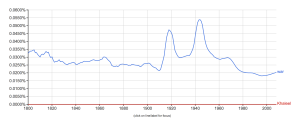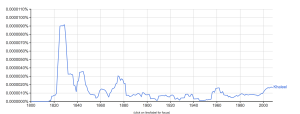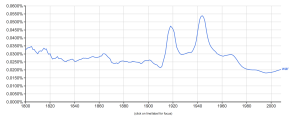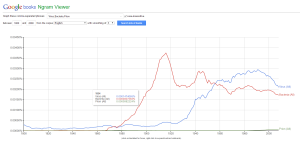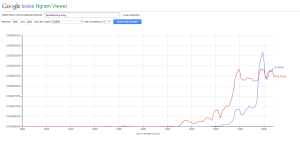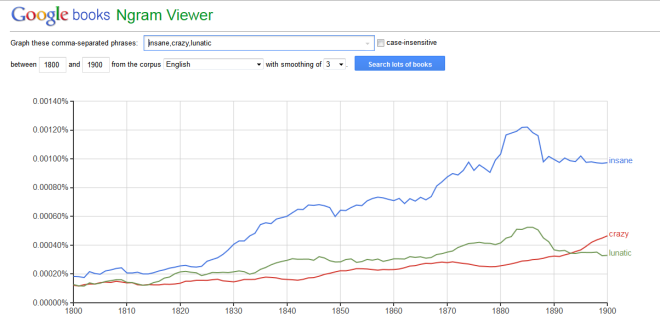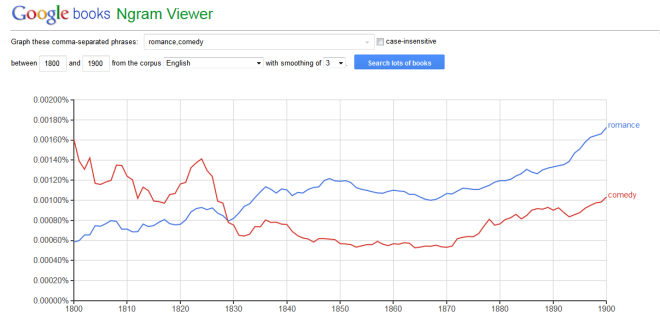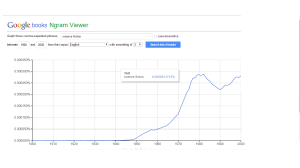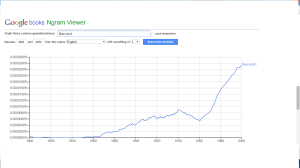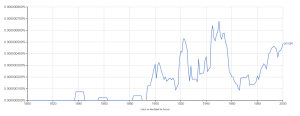For my first Google Ngram chart I used the terms “communism” and “fascism” and searched between the years 1800 and 2000.
The definitions of Communism and Fascism are as follows:
• Communism is a socioeconomic system structured upon common ownership of the means of production and characterized by the absence of social classes, money, and the state; as well as a social, political and economic ideology and movement that aims to establish this social order.
• Fascism is a form of radical authoritarian nationalism that came to prominence in early 20th-century Europe. Historians cannot agree on a set definition but have noticed certain trends when it comes to fascist movements; the veneration of the state, a devotion to a strong leader, and an emphasis on ultranationalism and militarism.
It was not surprising to me that Communism started to rise on the chart beginning in the mid-1800s. In 1848, Karl Marx and his associate Friedrich Engels published their famous pamphlet, The Communist Manifesto. It provided a new definition for communism amidst the advancement of the Industrial Revolution. From there, Communism seems to steadily increase in publications. Fascism does not begin to rise on the chart until over 70 years later, in 1919. This was when Fascism was founded, in post-WWI Italy by nationalist syndicalists.
Again, I was not surprised to see Communism and Fascism both increase in publications around the early 1930s. Though World War II did not begin until 1939, related conflicts began earlier. Around the 1940s, Fascism was much more prevalent in publications, as the leaders of Germany and Italy operated under Fascist regimes. Communism, however, did not see a great decrease, as China, Cuba, and North Korea, among others, were all Communist.
When World War II ended in 1945, the use of Fascism declined, as these movements/regimes were mostly disbanded, and not many nations nowadays are openly Fascist. However, Fascism is still fairly popular in publications, which I can only assume are publications on history and the war. Though the use of Communism declined as the use of Fascism increased during World War II, it steadily increased afterward. This is because of the Cold War, which was a period of political and military tension following the war between the United States (and its allies) and the Communist Soviet Union. Communism reaches its peak on the chart between 1961 and 1963, probably because of the Bay of Pigs Invasion and the Cuban Missile Crisis, both attempts by the United States the overthrow the Communist regime of Fidel Castro in Cuba. Both events were very important, so it makes sense that the use of Communism would increase during this time.
As Cold War tensions died down, so did the use of Communism. Though like Fascism it is still popular in publication, one can mostly assume it is a part of mostly history publications.
For my second Ngram chart, I decided to do something a little lighter than Communism and Fascism. I searched the characters “Marianne Dashwood,” “Elinor Dashwood,” and “Elizabeth Bennet.” Marianne and Elinor are characters for Jane Austen’s Sense and Sensibility while Elizabeth Bennet is the main character of Austen’s Pride and Prejudice.
It seems that the Dashwood sisters do not enjoy the same popularity as Elizabeth. Though Sense and Sensibility was the first work Jane Austen ever published, Pride and Prejudice could be seen as one of her, if not her most, popular works. Therefore, Elizabeth Bennet increases in publication as the years go on, but does seem to decline quite suddenly at random intervals, though that may be just the only way the chart is able to show it. Though I tried “smoothing it out” using larger numbers, these seemingly random drops still occurred.
Google Ngrams is a helpful tool that can help locate trends in a wide array of digitized works. However, lack of context is a big drawback of the tool. Without context, some of the trends and information could be highly misinterpreted. Overall though, I find Google Ngrams to be a fun and easy tool to use.






